News & Updates
Lotus - A trusted name in family travel
Terra Cotta Warriors Horses and Museum
The first Emperor of China, Qin Shi Huang arranged for his burial place long before his accession to the seat of supreme power. He was the first to unify China into a centralized state and helped advance the country significantly by imposing a single system of writing, money, weights and measures throughout the land. When he became king of Qin in 247 BC, he chose a site at the foot of Mount Li for his mausoleum. Work was commenced and was carried out more energetically with each new political and military success over his rivals Han, Zhao, Wei, Chu, Yan and Qi. Its treasures were safeguarded by automatically triggered weapons designed to thwart tomb robbers. 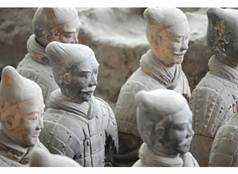
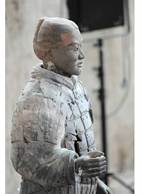
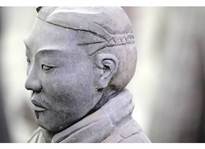
The design was organized to provide protection from invading barbarians that could arrive from any direction (the army which watches over the dead emperor faces outward from the tomb). It is estimated that roughly 700,000 workers from every province of the empire toiled unceasingly on the project until Qin’s death. 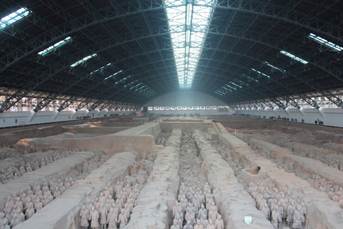 After Qin Shi Huang's death, the principal craftsmen were working in the mausoleum were permanently sealed inside, resulting in their deaths at the same time. This was on the orders of the second emperor and was a precaution against the craftsmen betraying their secrets.
After Qin Shi Huang's death, the principal craftsmen were working in the mausoleum were permanently sealed inside, resulting in their deaths at the same time. This was on the orders of the second emperor and was a precaution against the craftsmen betraying their secrets.
The mausoleum of Qin Shi 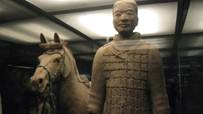 Huang, the first Emperor of China, is the largest preserved site in China. It is a unique architectural ensemble whose layout echoes the urban plan of the capital, Xianyang, with the Imperial Palace enclosed by the walls of the city. This massive mausoleum has survived for more than 2500 years and today is known as the Terra Cotta Warriors and Horses Museum, located a few miles outside of Xian, the current capital of Shaanxi province.
Huang, the first Emperor of China, is the largest preserved site in China. It is a unique architectural ensemble whose layout echoes the urban plan of the capital, Xianyang, with the Imperial Palace enclosed by the walls of the city. This massive mausoleum has survived for more than 2500 years and today is known as the Terra Cotta Warriors and Horses Museum, located a few miles outside of Xian, the current capital of Shaanxi province.
According to the latest archaeological excavation statistics, more than 8,000 terracotta figures and horses are laid out in three pits in the museum. They include foot soldiers, cavalries, sergeants and archers as well as war chariots and horses. It is a widely discussed fact that each terra cotta soldier has unique facial features and many hairstyles are also shown. Though each eye is a simple convex shape, it appears that the soldiers were individually 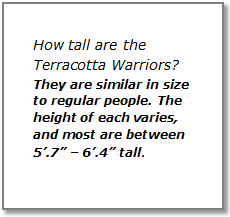 designed to show various emotions and perhaps display confidence. It is said that certain
designed to show various emotions and perhaps display confidence. It is said that certain 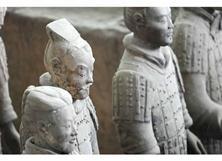 soldiers have squinty eyes and a tender smile to show their confidence to win the war. Other soldiers have eyes wide open in a fury, filled with hate toward their enemies; and some soldiers are looking down, shy and quiet. The soldiers looking forward have their eyeballs in the center of the eyelids, and those who looking up have the eyeballs titled up slightly. Also, the eyes of the Qin Terracotta Warriors depict a single eye-lid, which accurately represents the features of the eyes of the Qin people.
soldiers have squinty eyes and a tender smile to show their confidence to win the war. Other soldiers have eyes wide open in a fury, filled with hate toward their enemies; and some soldiers are looking down, shy and quiet. The soldiers looking forward have their eyeballs in the center of the eyelids, and those who looking up have the eyeballs titled up slightly. Also, the eyes of the Qin Terracotta Warriors depict a single eye-lid, which accurately represents the features of the eyes of the Qin people.
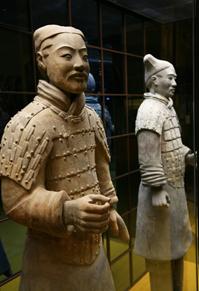 Because of their exceptional technical and artistic qualities, the terracotta warriors and horses and the funerary carts in bronze are major works in the history of Chinese sculpture prior to the Han dynasty. The army of statues also bears unique testimony to the military organization in China at the time of the Warring Kingdoms (475-221 BC) and that of the short-lived Empire of a Thousand Generations (221-210 BC) The direct testimony of the objects found in situ (lances, swords, axes, halberds, bows, arrows, etc.) is evident. No detail was neglected in the design of the Terra Cotta Warriors - from the uniforms of the warriors, their arms, to even the horses' halters – each design element was carefully and artistically crafted.
Because of their exceptional technical and artistic qualities, the terracotta warriors and horses and the funerary carts in bronze are major works in the history of Chinese sculpture prior to the Han dynasty. The army of statues also bears unique testimony to the military organization in China at the time of the Warring Kingdoms (475-221 BC) and that of the short-lived Empire of a Thousand Generations (221-210 BC) The direct testimony of the objects found in situ (lances, swords, axes, halberds, bows, arrows, etc.) is evident. No detail was neglected in the design of the Terra Cotta Warriors - from the uniforms of the warriors, their arms, to even the horses' halters – each design element was carefully and artistically crafted.
According to current estimates, the statue army of the Qin Shi Huang Mausoleum must have represented the exact number of the imperial guards. Over the past thirteen years, discoveries have revealed the dimensions of the mausoleum, and the site constitutes one of the most fabulous archaeological reserves in the world.
Source: UNESCO/CLT/WHC; People’s Government of Shaanxi Province, Lotus Travel & general travel sites